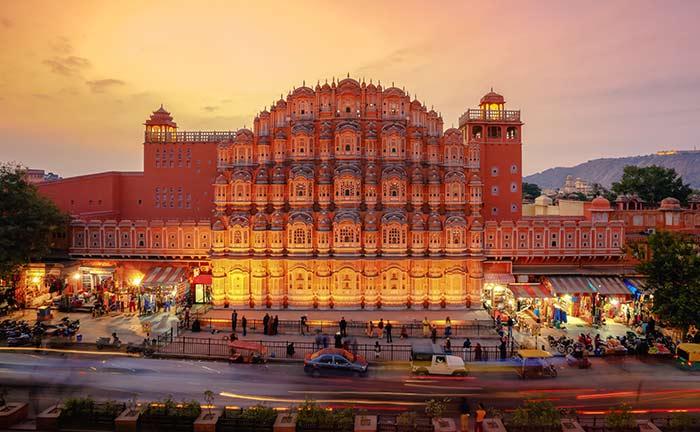Hawa Mahal: The Iconic Monument of Jaipur, Rajasthan

The Hawa Mahal, also known as the Palace of Winds, stands as a remarkable architectural marvel in the heart of Jaipur, Rajasthan. This iconic structure, built in 1799 by Maharaja Sawai Pratap Singh, showcases a blend of Rajput and Mughal architectural styles. With its intricate latticework and over 950 windows, Hawa Mahal offers an unparalleled glimpse into the cultural heritage of Rajasthan.
History of Hawa Mahal: A Palace Steeped in Legacy
The construction of Hawa Mahal was commissioned by Maharaja Sawai Pratap Singh, inspired by the unique architecture of the Khetri Mahal in Jhunjhunu. The primary purpose behind its creation was to provide a space for the royal women to observe daily life and festivals on the streets below while maintaining their privacy. This practice, known as purdah, was integral to the Rajput culture of the time.
The five-story structure, designed by Lal Chand Ustad, features an impressive facade resembling the honeycomb of a beehive. Its iconic pink and red sandstone construction aligns with Jaipur's title as the Pink City of India.
Architectural Brilliance of Hawa Mahal
Facade of Hawa Mahal
The most striking feature of Hawa Mahal is its meticulously designed facade, consisting of 953 small windows, or jharokhas, adorned with intricate latticework. These windows served a dual purpose: they allowed cool air (known as Venturi effect) to circulate through the palace, making it a perfect retreat during Jaipur’s scorching summers, and ensured that royal women could observe street festivities without being seen.
Interior Layout
While the exterior of Hawa Mahal is ornate, the interiors are relatively modest, comprising courtyards and passages that interconnect the different levels. The top floors provide a panoramic view of Jaipur, including prominent landmarks like Jantar Mantar and City Palace.
Combination of Rajput and Mughal Styles
Hawa Mahal’s design is a harmonious blend of Rajputana grandeur and Mughal symmetry. The fluted pillars, floral motifs, and domed canopies reflect the essence of Rajput architecture, while the arches and intricate stone inlays highlight Mughal influences.
Cultural Significance of Hawa Mahal
Hawa Mahal holds immense cultural significance as it embodies the lifestyle and traditions of the bygone era. It is not just an architectural masterpiece but also a symbol of Jaipur’s rich history. Today, it serves as a prominent tourist attraction, drawing visitors from around the globe who are eager to witness its magnificence.
Exploring Hawa Mahal: A Visitor’s Guide
Best Time to Visit
The ideal time to visit Hawa Mahal is during the winter months, between October and March, when the weather in Jaipur is pleasant. Early mornings are especially magical as the first rays of sunlight illuminate the palace, creating a breathtaking view.
Timings and Entry Fee
- Timings: 9:00 AM to 5:00 PM
- Entry Fee: ₹50 for Indian nationals and ₹200 for foreign tourists
(Prices may vary; please check before visiting.)
How to Reach Hawa Mahal
Hawa Mahal is conveniently located in the heart of Jaipur, making it accessible by various means of transportation:
- By Air: Jaipur International Airport is approximately 12 km from Hawa Mahal.
- By Train: Jaipur Junction Railway Station is about 6 km away.
- By Road: Local buses, taxis, and auto-rickshaws are readily available.
Nearby Attractions
While visiting Hawa Mahal, you can explore several nearby attractions:
- City Palace Jaipur: A royal residence showcasing Rajput architecture.
- Jantar Mantar Jaipur: A UNESCO World Heritage Site with ancient astronomical instruments.
- Albert Hall Museum: The oldest museum in Rajasthan, featuring an extensive collection of artifacts.
Photographing Hawa Mahal
For photography enthusiasts, Hawa Mahal offers a wealth of opportunities. The most popular spot to capture its facade is from one of the cafes opposite the monument. The play of light and shadow on its intricate latticework creates stunning visuals, especially during sunrise and sunset.
Interesting Facts About Hawa Mahal
- Unique Ventilation: Despite Jaipur’s hot climate, the intricate design ensures constant airflow, keeping the interiors cool.
- No Stairs: The upper floors of Hawa Mahal are accessible via ramps instead of stairs.
- Symbol of Feminine Grace: The structure’s delicate design is often likened to the crown of Lord Krishna.
Preservation and Legacy
Efforts have been made to preserve Hawa Mahal’s historical integrity. The Archaeological Department of Rajasthan oversees its maintenance, ensuring that this iconic monument continues to captivate future generations.
Hawa Mahal is more than just a monument; it is a timeless testament to Jaipur’s royal heritage and architectural brilliance. A visit to this landmark is a journey through history, art, and culture, offering memories that will last a lifetime.
- Art
- Causes
- Crafts
- Dance
- Drinks
- Film
- Fitness
- Food
- Jocuri
- Gardening
- Health
- Home
- Literature
- Music
- Networking
- Alte
- Party
- Religion
- Shopping
- Sports
- Theater
- Wellness
- Politics
- IT
- Relationship
- Blockchain
- NFT
- Crypto
- Fintech
- Automobile
- Faith
- Family
- Animals
- Travel
- Pets
- Coding
- Comedy
- Movie
- Joc
- Computer



